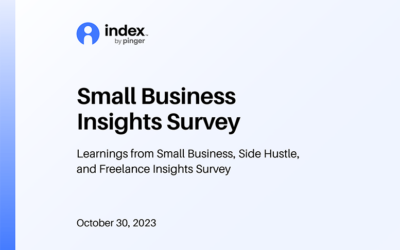7 Trends for Small Businesses in 2024
By Index Staff

What’s in store for 2024? Although it’s impossible to predict what the future will hold, there are some trends that can dramatically affect small businesses in the next 12 months.
What Is a Business Trend?
A business trend is a change or development that affects how certain companies operate. Trends can emerge from new technologies, shifts in consumer behavior, economic factors, regulatory changes, or broader societal changes. Understanding and adapting to relevant business trends is crucial for companies to remain competitive and innovative.
Key characteristics of business trends include
- Influential: Trends can influence a wide range of industries and sectors, not just a single area of business.
- Predictive: Trends indicate a shift in how businesses operate, market, or produce their product or service. Trends can signal a change in the way things are done.
- Quantifiable: Trends are often measurable through quantifiable data or observable changes in business practices and consumer behavior.
Identifying and understanding trends can help business owners predict future market directions and consumer needs.
With this in mind, here are seven trends to watch in 2024.
7 Trends That Could Impact Your Business
1. Generative AI: The Power of Automation
Generative Artificial Intelligence, or Gen AI, is here to stay and is revolutionizing how small businesses operate. With the ability to automate repetitive tasks, analyze data and make predictions, AI is helping small companies streamline operations, increase efficiency and reduce costs. Businesses that embrace AI can gain a competitive edge. According to Constant Contact’s “Small Business Now Report,” 91% of small businesses currently using AI say it has made their business more successful.
Don’t know how to capitalize on this trend? First, learn about AI’s potential: what it can—and cannot—do. Also, become familiar with the risks of AI.
Then identify areas where AI could help your business. Possible applications include customer support chatbots, AI-driven content creation, personalization of marketing programs, and data analysis for informed decision-making.
Here are two articles to get started: “How AI Can Transform Your Small Business” and “6 AI Tools for Your Small Business.”
In the interest of full disclosure, we’re revealing that ChatGPT, probably the best-known Gen AI chatbot, “wrote” the first draft of this article. It’s also important to note that we (the people at Index by Pinger) took over from there and added some human touch through expanding, revising, and editing—a topic we’ll touch on next.
2. The Importance of the Human Touch: The Personalized Customer Experience
In a world increasingly dominated by technology—especially Gen AI—the human touch is more important than ever. Personalized customer experiences build lasting relationships and drive customer loyalty. Businesses that prioritize human interaction will stand out in a crowded marketplace.
How can you take advantage of this trend? Find ways to improve customer experiences and make your marketing more targeted, precise, and personalized. Tailor your products, services, and marketing to individual customer needs and preferences. Tools such as Index by Pinger can help you personalize your communications with your customers quickly and easily.
For more tips on how to capitalize on this trend, see “Making it Personal: Your Small Business Superpower.”
3. Cybersecurity, Data Security, and Privacy: Earning Customer Trust
As business operations become more digital, data breaches are becoming more devastating and frequent. Unfortunately, smaller companies are prime targets for cyber attacks because they are usually less protected against such threats than larger companies.
It’s no wonder consumers want to know that their information is secure and responsibly managed. Cybersecurity and data privacy are essential to protect your data and customers’ sensitive information. Protecting data is the right thing to do and reduces the possibility you’ll suffer costly business interruptions and potential lawsuits from data breaches.
How can you protect your company against data breaches? First, prioritize data privacy and security. Then invest in cybersecurity measures and educate your employees about online security practices.
To learn more, check out technology expert and radio host Kim Komando’s article “4 Quick Cybersecurity Steps to Take Now,” and the Federal Trade Commission’s article on “Cybersecurity for Small Business.”
4. Digital Marketing: Establishing an Online Presence
Because consumers increasingly look for information and products online, a solid online presence is essential. Digital tools and platforms can streamline operations, improve the customer experience, and expand market reach.
To take advantage of this trend, create or expand your digital presence, including your:
- Website
- Social media
- Videos: on your website, social media channels, and online point-of-sale locations like Amazon and Etsy.
Create valuable content. Engage with your customers through social media. And implement search engine optimization (SEO) strategies to improve your online visibility. And be sure to maintain a consistent brand image across all your marketing channels.
For more tips, see the article “Marketing Your Business: 6 Ways to Make a Great Online Impression.”
5. Expansion of E-commerce: The New Normal
E-commerce continues to thrive and shows no signs of slowing down. A robust e-commerce presence can significantly expand your business’s reach and increase revenue.
To capitalize on this trend, invest in user-friendly e-commerce platforms, optimize your online presence, and offer convenient shipping and payment options. Inc. Magazine small business columnist Steve Strauss discusses marketing in this “Small Business Basics” video, and business management expert James Monroe offers “10 Ways to Leverage Small Business Month to Springboard Your Marketing.”
6. Focus on Sustainability: Meeting Consumer Expectations
Consumers are increasingly voting with their wallets in favor of businesses that prioritize sustainability. They prefer to buy from companies that are environmentally conscious and socially responsible.
To capitalize on this trend, show in word and deed that you are committed to eco-friendly practices. For example, you could:
- Source sustainable materials
- Reduce your carbon footprint
- Adopt renewable energy sources, and
- Reduce waste
And be sure to communicate your commitment to sustainability and social responsibility to attract environmentally conscious consumers.
7. Transparent Business Practices: Building Trust
Today, business transparency is paramount. Small businesses that openly share their values and beliefs, processes, and business ethics will earn the trust of their customers, employees, and other associates. Transparency builds credibility, fosters community, enhances accountability, and can mitigate risks.
How can you build transparency? Honestly share appropriate information, both internally and externally, about your company’s operations, performance, policies, and decision-making processes. Provide stakeholders with relevant information to make informed decisions and build trust.
Trends for Success
Small businesses that embrace these trends can dramatically increase their likelihood of success. By staying alert and adaptive in today’s ever-changing business landscape, small businesses can thrive in 2024 and beyond.
For more tips on starting and running your small business, visit the Index by Pinger Small Business Resource Center.
Recommended Reading
Streamline customer interactions with Index
The Index app was built specifically for small businesses, with tools to help you communicate faster and more easily with your customers. Try Index risk-free for 7 days.




